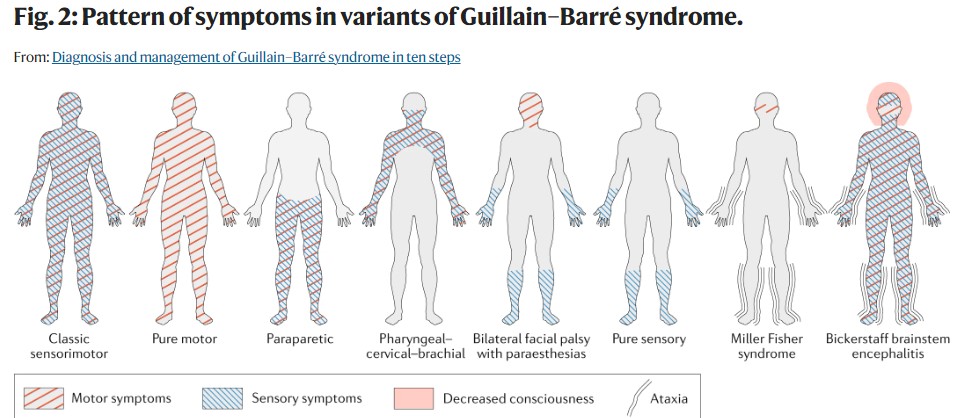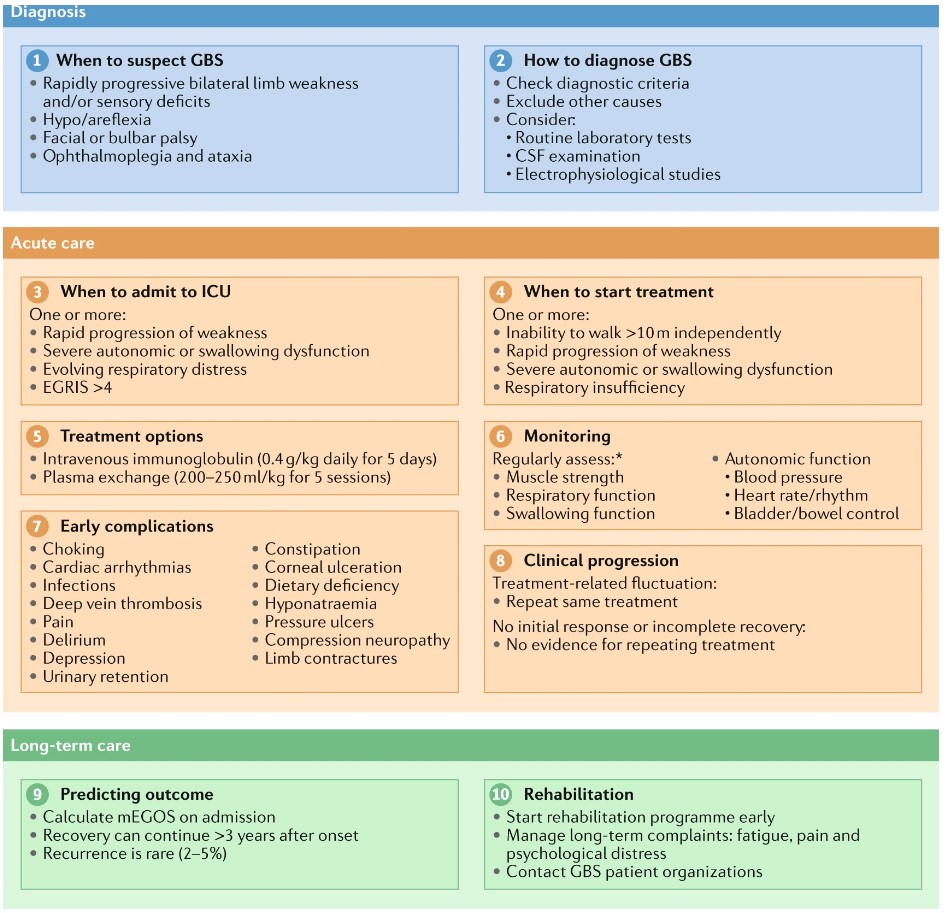Makindo Medical Notes"One small step for man, one large step for Makindo" |
|
|---|---|
| Download all this content in the Apps now Android App and Apple iPhone/Pad App | |
| MEDICAL DISCLAIMER: The contents are under continuing development and improvements and despite all efforts may contain errors of omission or fact. This is not to be used for the assessment, diagnosis, or management of patients. It should not be regarded as medical advice by healthcare workers or laypeople. It is for educational purposes only. Please adhere to your local protocols. Use the BNF for drug information. If you are unwell please seek urgent healthcare advice. If you do not accept this then please do not use the website. Makindo Ltd. |
Guillain Barre Syndrome
-
| About | Anaesthetics and Critical Care | Anatomy | Biochemistry | Cardiology | Clinical Cases | CompSci | Crib | Dermatology | Differentials | Drugs | ENT | Electrocardiogram | Embryology | Emergency Medicine | Endocrinology | Ethics | Foundation Doctors | Gastroenterology | General Information | General Practice | Genetics | Geriatric Medicine | Guidelines | Haematology | Hepatology | Immunology | Infectious Diseases | Infographic | Investigations | Lists | Microbiology | Miscellaneous | Nephrology | Neuroanatomy | Neurology | Nutrition | OSCE | Obstetrics Gynaecology | Oncology | Ophthalmology | Oral Medicine and Dentistry | Paediatrics | Palliative | Pathology | Pharmacology | Physiology | Procedures | Psychiatry | Radiology | Respiratory | Resuscitation | Rheumatology | Statistics and Research | Stroke | Surgery | Toxicology | Trauma and Orthopaedics | Twitter | Urology
Related Subjects: |Herpes Varicella-Zoster (Shingles) Infection |Herpes Viruses |Herpes Zoster Ophthalmicus (HZO) Shingles |MonkeyPox |Mumps |Measles |Rubella (German Measles) |Epstein-Barr Virus infection |Cytomegalovirus (CMV) infections |CMV retinitis infections |Toxoplasmosis |Respiratory Failure
🧠 Guillain-Barré Syndrome (GBS): Respiratory function must always be monitored, as failure may occur silently without dyspnoea. ⚠️ Around 20% of patients need mechanical ventilation. 📏 Bedside test = Forced Vital Capacity (FVC); <1.5 L suggests ITU admission. 💉 IVIG within 2 weeks of onset is as effective as plasma exchange (Cochrane review) and more likely to be completed.
🩺 Initial Management of GBS
| Initial Priorities |
|---|
|
📖 About
- Acute onset ascending weakness + areflexia 🔽.
- Potentially life-threatening due to autonomic or respiratory failure.
- Also called Acute Inflammatory Demyelinating Polyneuropathy (AIDP).
🧬 Aetiology
- ⚔️ Autoimmune attack against peripheral nerves (molecular mimicry).
- 🌱 Infectious triggers: Campylobacter jejuni, CMV, HIV, HEV, EBV, Mycoplasma, Zika, Lyme.
- Pathology: multifocal demyelination + high CSF protein (albuminocytologic dissociation).
🔎 Subtypes of GBS
- AIDP (90%) – classic form, demyelinating.
- AMAN (5%) – acute motor axonal neuropathy, often after Campylobacter.
- Miller-Fisher (5%) – triad: ophthalmoplegia 👁️, ataxia 🚶, areflexia.
- AMSAN (1%) – motor + sensory axonal neuropathy.
⚠️ Clinical Features
- 🔼 Ascending weakness (legs → trunk → arms → cranial nerves).
- ❌ Areflexia.
- 🫁 Respiratory weakness ± need for ventilation.
- ❤️ Dysautonomia: BP swings, arrhythmias, pupillary changes.
- 🩻 Back pain, sensory loss, cranial neuropathies.
- 👀 Papilloedema possible due to high CSF protein.

🧪 Investigations
- 🧫 CSF: Protein ↑, normal WCC (may be normal early).
- ⚡ NCS: Slowed conduction, absent F-waves, conduction block.
- 🫀 ECG: monitor for arrhythmias.
- 🧬 Antibody testing rarely useful (anti-GD1a, anti-GQ1b in Miller-Fisher).
🩻 Differentials
- Spinal cord lesions (transverse myelitis).
- Myasthenia gravis, botulism.
- Tick paralysis, diphtheria, poliomyelitis.
- Acute porphyria.
🚨 Indications for ITU/Intubation
- FVC <15–20 ml/kg or <1 L.
- 🫁 Abnormal inspiratory/expiratory pressures.
- ❌ Severe bulbar weakness or impaired cough.
- 📉 Autonomic instability or abnormal gases.
💊 Management
- Specific: IVIG (within 2 weeks) or plasma exchange (within 4 weeks). 🚫 Steroids ineffective.
- Supportive: ITU if required, VTE prophylaxis, physiotherapy, speech therapy, nutrition support.
- Pain: Neuropathic analgesia (gabapentin, carbamazepine). Avoid amitriptyline (arrhythmia risk).
📈 Outcome
- Most improve within 12 months, but recovery may continue up to 5 years.
- 85% recover well; 15% left with disability.
- Poor prognosis: rapid onset, older age, preceding diarrhoea, severe initial weakness.
⚠️ Complications
- Bulbar dysfunction → aspiration, malnutrition.
- Autonomic storms → arrhythmias, BP swings.
- Immobility → pressure sores, DVT/PE, infections.

📚 References
Cases — Guillain–Barré Syndrome (GBS)
- Case 1 — Classic Post-Infectious Ascending Weakness 🦵: A 32-year-old man develops tingling in his feet one week after a Campylobacter gastroenteritis. Over 3 days, he develops progressive ascending weakness, now unable to climb stairs. Exam: bilateral foot drop, absent ankle reflexes, intact cranial nerves. Diagnosis: Acute inflammatory demyelinating polyneuropathy (AIDP, most common GBS subtype). Management: Admit for monitoring; IV immunoglobulin (IVIG) or plasma exchange; monitor vital capacity regularly.
- Case 2 — Miller–Fisher Variant 👁️: A 45-year-old woman presents with acute diplopia and unsteady gait. Exam: ophthalmoplegia, ataxia, and areflexia, but normal limb strength. CSF shows albuminocytologic dissociation. Anti-GQ1b antibodies positive. Diagnosis: Miller–Fisher variant of GBS. Management: IVIG; supportive physiotherapy and rehabilitation.
- Case 3 — Severe GBS with Respiratory Involvement 🫁: A 28-year-old man presents with progressive ascending weakness, facial diplegia, and dysphagia. Exam: bilateral flaccid paralysis, absent reflexes, reduced single-breath count. Diagnosis: Severe GBS with bulbar and respiratory muscle involvement. Management: Admit to ICU; intubation and ventilation if vital capacity falls; IVIG or plasma exchange; multidisciplinary supportive care.
Teaching Commentary 🧠
GBS is an acute, immune-mediated polyneuropathy triggered by infections (e.g. Campylobacter, EBV, CMV, HIV) or rarely vaccination. Hallmarks: progressive symmetrical weakness (usually ascending), areflexia, mild sensory symptoms, autonomic instability (arrhythmias, BP swings). Investigations: - CSF: albuminocytologic dissociation (↑protein, normal cells). - Nerve conduction: demyelination (slowed conduction, conduction block). Complications: respiratory failure (20–30%), autonomic dysfunction. Treatment: IVIG or plasma exchange (equally effective); steroids are not helpful. Monitor in hospital until clear plateau or recovery.